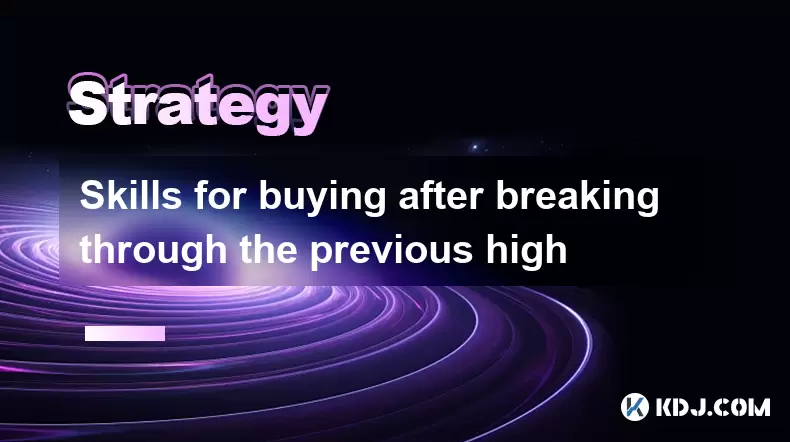-
 bitcoin
bitcoin $122288.232522 USD
0.16% -
 ethereum
ethereum $4480.662914 USD
-0.22% -
 xrp
xrp $2.962747 USD
-2.32% -
 tether
tether $1.000120 USD
-0.05% -
 bnb
bnb $1145.654223 USD
-2.07% -
 solana
solana $227.105217 USD
-1.67% -
 usd-coin
usd-coin $0.999548 USD
-0.02% -
 dogecoin
dogecoin $0.250875 USD
-2.04% -
 tron
tron $0.340654 USD
-0.49% -
 cardano
cardano $0.837968 USD
-2.52% -
 hyperliquid
hyperliquid $48.960449 USD
0.06% -
 chainlink
chainlink $22.049280 USD
-1.33% -
 ethena-usde
ethena-usde $1.000404 USD
0.02% -
 sui
sui $3.586212 USD
0.20% -
 avalanche
avalanche $29.894916 USD
-4.18%
Skills for buying after breaking through the previous high
After a crypto breaks its previous high, analyze market conditions, identify entry points, and use risk management to decide when to buy for potential gains.
Jun 09, 2025 at 06:08 pm

Understanding the Concept of Breaking Through the Previous High
In the world of cryptocurrency, breaking through the previous high refers to a situation where a digital asset's price surpasses its highest point ever recorded. This event is significant because it often signals strong bullish momentum and can attract more investors looking to capitalize on the upward trend. For traders and investors, knowing how to buy after such a breakthrough can be a valuable skill, as it may offer opportunities for substantial gains.
When a cryptocurrency breaks through its previous high, several factors come into play. These include market sentiment, trading volume, and news or events that may have triggered the surge. Understanding these elements can help investors make informed decisions about when and how to enter the market. The key is to approach such situations with a strategic mindset, focusing on risk management and potential reward.
Analyzing Market Conditions Post-Breakthrough
After a cryptocurrency breaks through its previous high, it's crucial to analyze the market conditions to determine the best time to buy. Market analysis involves looking at various indicators such as price charts, trading volume, and technical indicators like moving averages and relative strength index (RSI). These tools can provide insights into whether the breakout is likely to sustain or if it's a false signal.
One of the first steps in this process is to review the price chart. Look for a clear and decisive move above the previous high, accompanied by high trading volume. This can indicate strong buying interest and suggest that the breakout is genuine. Additionally, checking the RSI can help determine if the asset is overbought or if there's still room for further gains.
Identifying Entry Points
Once you've analyzed the market conditions, the next step is to identify potential entry points. Entry points are specific price levels where you feel comfortable entering the market. After a breakthrough, there are several strategies you can use to find these points.
Waiting for a Retest: Often, after breaking through a previous high, the price may pull back to retest the level before continuing its upward trend. Buying during this retest can be a safer entry point, as it allows you to enter at a slightly lower price while still participating in the potential upward movement.
Using Technical Indicators: Tools like moving averages and support/resistance levels can help identify entry points. For instance, if the price pulls back to a key moving average after breaking through the high, this could be an ideal entry point.
Monitoring Volume: High trading volume during the breakthrough and subsequent movements can confirm the strength of the trend. Look for volume spikes as potential entry signals.
Risk Management Strategies
Buying after a breakthrough comes with its own set of risks, and effective risk management is essential. One of the key strategies is to set stop-loss orders. A stop-loss order is an instruction to sell the asset if it falls to a certain price, helping to limit potential losses.
Determine Stop-Loss Levels: Calculate your stop-loss levels based on your risk tolerance and the asset's volatility. A common approach is to set the stop-loss just below the previous high or a significant support level.
Position Sizing: Decide how much of your portfolio to allocate to the trade. A general rule of thumb is not to risk more than 1-2% of your total capital on a single trade.
Diversification: Even if you're confident about the breakout, it's wise to diversify your investments across different assets to spread the risk.
Executing the Trade
Once you've identified your entry points and set your risk management strategies, it's time to execute the trade. Here's a step-by-step guide on how to do this:
Choose a Reliable Exchange: Ensure you're using a reputable cryptocurrency exchange that offers the asset you want to buy. Popular exchanges include Binance, Coinbase, and Kraken.
Fund Your Account: Deposit funds into your exchange account. Make sure you have enough to cover the trade and any potential fees.
Place Your Order: Decide whether to place a market order or a limit order. A market order will execute immediately at the current market price, while a limit order will only execute at your specified price.
Monitor the Trade: Keep an eye on the trade after it's executed. Be prepared to adjust your stop-loss or take profits if the market moves in your favor.
Review and Learn: After the trade is complete, review your performance. What went well? What could you improve? Use these insights to refine your strategy for future trades.
Utilizing Fundamental Analysis
While technical analysis is crucial for timing your entry, fundamental analysis can provide a deeper understanding of the cryptocurrency's long-term potential. This involves evaluating the project's fundamentals, such as its technology, team, partnerships, and overall market demand.
Research the Project: Look into the cryptocurrency's whitepaper, roadmap, and any recent developments. Understanding the project's goals and progress can help you gauge its potential for growth.
Evaluate the Team: A strong and experienced team is often a good indicator of a project's success. Check the team's background, their previous projects, and their activity in the community.
Assess Market Demand: Consider the overall market demand for the cryptocurrency. Is it solving a real-world problem? Is there a growing user base? These factors can influence the asset's price trajectory.
Frequently Asked Questions
Q: How can I tell if a breakout is genuine or a false signal?A: To determine if a breakout is genuine, look for high trading volume accompanying the price movement. Additionally, check if the price holds above the previous high for a sustained period. Technical indicators like the RSI can also help; if the RSI is not in overbought territory, it may indicate that the breakout has more room to run.
Q: Should I buy immediately after a cryptocurrency breaks through its previous high?A: It's generally not advisable to buy immediately after a breakout. Waiting for a retest or using technical indicators to confirm the breakout can provide safer entry points. Immediate buying can expose you to the risk of a false breakout.
Q: How do I set an effective stop-loss after buying post-breakthrough?A: An effective stop-loss should be set just below the previous high or a significant support level. This helps protect your investment if the price falls back below the breakout level. Consider your risk tolerance and the asset's volatility when setting the stop-loss level.
Q: Can fundamental analysis be used alone to decide when to buy after a breakthrough?A: While fundamental analysis is important for understanding a cryptocurrency's long-term potential, it should be used in conjunction with technical analysis for timing your entry after a breakthrough. Technical analysis helps identify the best entry points, while fundamental analysis provides context on the project's overall viability.
Disclaimer:info@kdj.com
The information provided is not trading advice. kdj.com does not assume any responsibility for any investments made based on the information provided in this article. Cryptocurrencies are highly volatile and it is highly recommended that you invest with caution after thorough research!
If you believe that the content used on this website infringes your copyright, please contact us immediately (info@kdj.com) and we will delete it promptly.
- BlockDAG, DOGE, HYPE Sponsorship: Crypto Trends Shaping 2025
- 2025-10-01 00:25:13
- Deutsche Börse and Circle: A StableCoin Adoption Powerhouse in Europe
- 2025-10-01 00:25:13
- BlockDAG's Presale Buzz: Is It the Crypto to Watch in October 2025?
- 2025-10-01 00:30:13
- Bitcoin, Crypto, and IQ: When Genius Meets Digital Gold?
- 2025-10-01 00:30:13
- Stablecoins, American Innovation, and Wallet Tokens: The Next Frontier
- 2025-10-01 00:35:12
- NBU, Coins, and Crypto in Ukraine: A New Yorker's Take
- 2025-10-01 00:45:14
Related knowledge

Practical parameter settings for a Bitcoin multi-timeframe moving average system
Sep 18,2025 at 10:54pm
Optimizing Timeframe Combinations for Bitcoin Trading1. Selecting appropriate timeframes is crucial when building a multi-timeframe moving average sys...

How can I filter out false breakouts in Dogecoin high-frequency trading?
Sep 22,2025 at 01:00am
Understanding False Breakouts in Dogecoin Trading1. A false breakout occurs when Dogecoin's price appears to move beyond a defined support or resistan...

Techniques for identifying tops and bottoms in the Bitcoin on-chain NVT model
Sep 20,2025 at 07:54pm
Understanding the NVT Model in Bitcoin Analysis1. The Network Value to Transactions (NVT) ratio is often described as the 'P/E ratio' of the cryptocur...

What does the surge in open interest in Bitcoincoin futures mean?
Sep 20,2025 at 11:18pm
Understanding the Surge in Dogecoin Futures Open Interest1. A surge in open interest within Dogecoin futures indicates a growing number of active cont...

How can I use the Ethereum USDT premium to gauge market sentiment?
Sep 18,2025 at 11:55pm
Understanding the Ethereum USDT Premium1. The Ethereum USDT premium refers to the price difference between USDT (Tether) traded on Ethereum-based plat...

What should I do if Ethereum staking yields decline?
Sep 20,2025 at 06:18am
Understanding the Causes Behind Declining Ethereum Staking Yields1. The Ethereum network transitioned to a proof-of-stake consensus mechanism with the...

Practical parameter settings for a Bitcoin multi-timeframe moving average system
Sep 18,2025 at 10:54pm
Optimizing Timeframe Combinations for Bitcoin Trading1. Selecting appropriate timeframes is crucial when building a multi-timeframe moving average sys...

How can I filter out false breakouts in Dogecoin high-frequency trading?
Sep 22,2025 at 01:00am
Understanding False Breakouts in Dogecoin Trading1. A false breakout occurs when Dogecoin's price appears to move beyond a defined support or resistan...

Techniques for identifying tops and bottoms in the Bitcoin on-chain NVT model
Sep 20,2025 at 07:54pm
Understanding the NVT Model in Bitcoin Analysis1. The Network Value to Transactions (NVT) ratio is often described as the 'P/E ratio' of the cryptocur...

What does the surge in open interest in Bitcoincoin futures mean?
Sep 20,2025 at 11:18pm
Understanding the Surge in Dogecoin Futures Open Interest1. A surge in open interest within Dogecoin futures indicates a growing number of active cont...

How can I use the Ethereum USDT premium to gauge market sentiment?
Sep 18,2025 at 11:55pm
Understanding the Ethereum USDT Premium1. The Ethereum USDT premium refers to the price difference between USDT (Tether) traded on Ethereum-based plat...

What should I do if Ethereum staking yields decline?
Sep 20,2025 at 06:18am
Understanding the Causes Behind Declining Ethereum Staking Yields1. The Ethereum network transitioned to a proof-of-stake consensus mechanism with the...
See all articles










































































